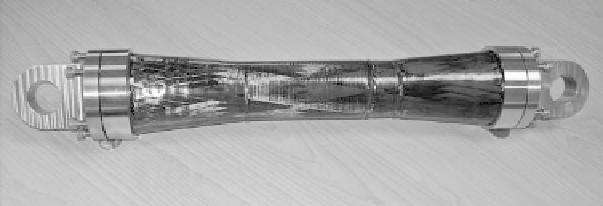Environmental Engineering Reference
In-Depth Information
Then, retaining the successful 8 MW HTS design, the foundation was replaced
with an alternative more suited to such large turbines in relatively deep water. With
this confi guration, the 8 MW HTS turbines resulted in a 17% reduction in the cost
of energy relative to the baseline, in the same pre-series volumes. The analysis
included the effi ciency benefi ts of HTS generators, but only at part load, since at
wind speeds greater than the minimum required for full load output only part of
the kinetic energy is extracted from the wind and the benefi t of increased generator
effi ciency is limited to reducing the load on the mechanical components. Work is
progressing with a wind turbine manufacturer towards the design and cost analysis
of a new giant turbine, in serial volumes, prior to demonstrator deployment.
6.6 Model generator
Following the completion of the concept design, work started on the design of
the scaled demonstration 'Model Generator'. Apart from the use of 1G HTS wire
rather than 2G, due to the limited availability and performance of 2G at the time
of the wire purchase, the model generator uses scaled components of the same
type as in the full size generator. The rating of the machine was constrained by the
project budget for HTS wire, and was chosen to be 500 kW at 30 rpm.
At the time of writing (December 2008) the design of the major components has
been completed, and manufacturing was in progress. Manufacturing and testing of
this generator is expected to be completed in 2010.
6.7 Material testing and component prototypes
An important part of the de-risking process for new technology is the manufacture
and test of prototype components.
A test facility was established at the University of Warwick with a cryostat to
enable mechanical and thermal testing of small components at room temperature
and down to a temperature of 30 K. Other tests included material properties for
the support teeth for the airgap stator winding. Figure 17 shows a carbon fi bre
cold-to-warm torque link for the model generator, prior to mechanical testing.
It was also considered essential to manufacture and test smaller versions of the
HTS coils. During the concept design phase, three HTS coils were made to a
design similar to the model generator and full size coils, which were tested in a
Figure 17: Torque link.

Search WWH ::

Custom Search